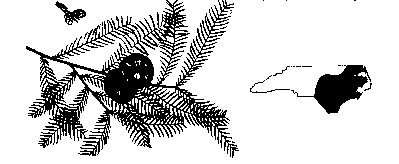|
Baldcypress
(Taxodium
distichum (L) Rich.)
|
|
| |
 |
|
| |
Cypress,
or baldcypress, is found in deep swamps that usually are flooded
for long periods of time and on wet stream banks and wet bottomlands.
The leaves of the cypress are 1/2 to 3/4 inches long and are arranged
in featherlike fashion along two sides of small branchlets, which
fall in autumn with the leaves still attached. On rapidly growing
leaders, the leaves are scale-like and much shorter, light green
and sometimes silvery below.
The fruit is a rounded cone, or "ball," about one inch in diameter,
consisting of thick, irregular scales. The bark is dark reddish
brown to silvery brown and is finely divided by many longitudinal
fissures.
Baldcypress has a straight trunk with numerous ascending branches
and a narrow conical crown, which makes the tree very beautiful.
The root system frequently produces irregular conical structures,
called "knees," that rise from the roots. In old age, the tree
generally has a broad, fluted base, a smooth, slowly tapering
trunk and a broad, open, flat top with a few heavy branches and
many small branchlets. Old-growth trees reach heights of 90 to
120 feet and diameters of 3 to 6 feet.
Baldcypress wood is light, soft, easily worked and varies in color
from a creamy sapwood to brown heartwood. Because it is particularly
resistant to decay, baldcypress is in demand for exterior trim
of buildings, greenhouse planking, boatbuilding, shingles, posts,
poles and crossties.
Pond Cypress (Taxodium distichum var. imbricarium (Nutt) Croom)
Pond cypress differs from baldcypress mainly because its leaves
are awl-like and fit closely on the twig. The bark of pond cypress
is much grayer than that of baldcypress. Pond cypress gets its
name from where it most often grows -- in ponds in the flat pinelands.
Its other characteristics and uses are similar to baldcypress.
Because the foliage of many of these trees closely resembles both
that of the pond cypress and baldcypress, some botanists believe
there is only one species. |
|
|

